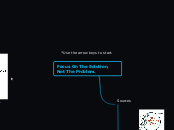Focus On The Solution, Not The Problem.
Sources

1. The Anatomy Of Peace: Resolving Heart Conflict. San Francisco: Berrett-Koehler, 2006.

2. Heath, Chip, and Dan Heath. Decisive: How To Make Better Decisions In Life And Work. London: Random House Books, 2014.

3. Heath, Chip, and Dan Heath. Switch: How To Change Things When Change Is Hard. London: Random House Business, 2011.
This doesn't mean ignoring problems. It means approaching them in the right way.
This is especially harmful when when we feel like the problem is "someone else's."
Unfortunately, most of us get the pyramid backwards.
We spend most of our time trying to correct the problem...
Instead of helping the solution.
How we should approach problems.

Remember what we were trying to accomplish and why.

Learn why we didn't achieve it.

Use the lesson to improve.

This process allows you to learn from your problems, instead of getting frustrated by them.
This is "The Influence Pyramid."
It represents where we spend our time and energy when trying to solve problems.

Replicate your solution.

How can you replicate your "Bright Spot" solution to solve this problem?

It doesn't have to be a perfect match...

It just needs to get you closer to your target.
Follow these steps to a solution.

#1 Remind yourself of your purpose.

#2 State your ideal outcome.

#3 Learn why the problem occurred.

#4 Use the lesson to improve.

#5 Find your "Bright Spots."

#6 Create a plan to replicate your success.

#7 Solve the problem.
Focus on concrete, objective factors – specific behaviors, environment, resources, etc.
*Use the arrow keys to start.

Once you understand the problem, turn all of your focus toward working on the solution.
How we typically approach problems.

Get emotional about poor results.

Try to find someone or something to blame.

Spend our time and energy finding justification for that blame.

